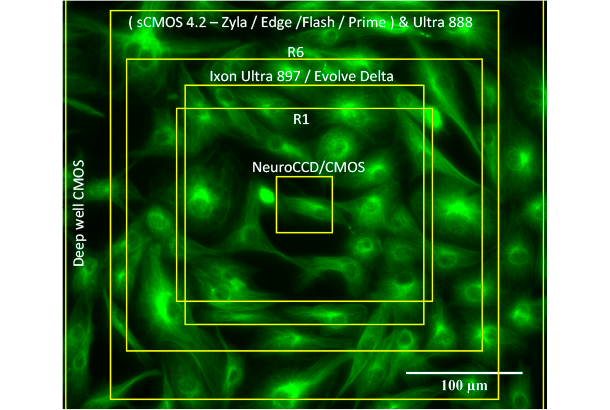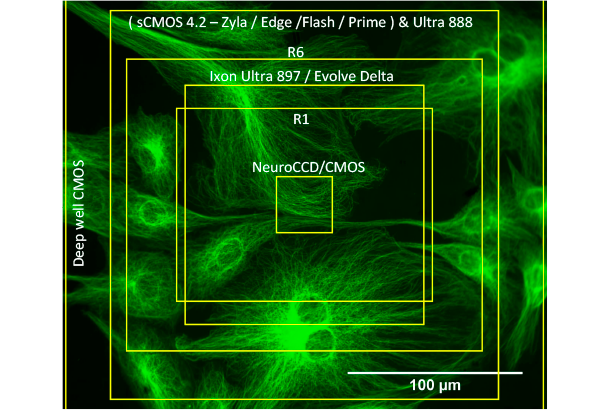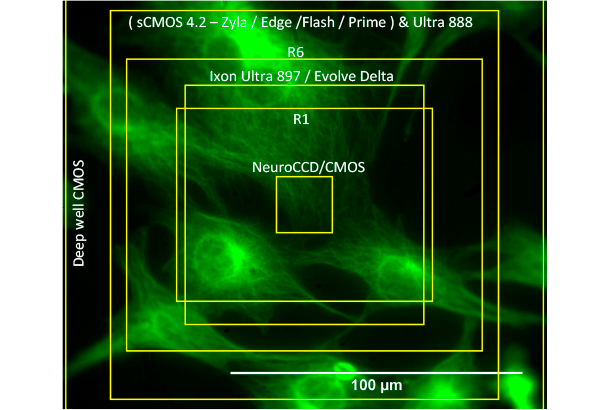Camera Field of View Comparison

10X magnification Field of View ( sCMOS 5.5 – Zyla / Edge )

40X magnification Field of View ( sCMOS 5.5 – Zyla / Edge )

60X magnification Field of View ( sCMOS 5.5 – Zyla / Edge )

100X magnification Field of View ( sCMOS 5.5 – Zyla / Edge )
We are delighted to offer a range of selected and tested scientific cameras from industry leading manufacturers to run with our products and systems. Recent advances have made it increasingly difficult to characterise scientific microscope cameras based on user application or camera technology, but (to avoid the bewildering list seen on some websites) we have done our best. As with other third-party (and in some cases competing) products we are fiercely independent and will always recommend what we believe to be the best scientific camera for your application.
Firstly, there are what we would call entry-level microscope cameras, which are primarily aimed at transmitted light techniques, fixed samples and non-quantitative requirements. In most fields these would be considered to be high end products, but from a live-cell fluorescence imaging standpoint the detector is arguably the second most important component, after the objective lens, so it makes sense to invest in a device with comprehensive support, high dynamic range, high sensitivity and appropriate resolution and field of view. Where prices have dropped for these cameras over the years, all of the digital microscope cameras we supply for fluorescence will perform at least as well as devices costing two or three times more a few years ago.
Our second category covers high-speed, high-resolution cameras based on scientific CMOS sensors. These devices offer very high sensitivity, frame rates, fields of view and resolution at an attractive price point, and are now the mainstay of most micro imaging labs. More recently, back-illuminated sensors have become available offering even greater sensitivity and fields of view. For researchers requiring low dark current for long exposures (luminescence applications) we still offer the high sensitivity and low-noise gain of Electron Multiplication (EM) camera.
Finally, we offer several dedicated Specialist camera systems for very high speed neuro and cardio imaging, contractility, macroscopy and other niche applications. These microscope cameras are generally supported in fewer software environments and would be sold as part of a turnkey system.
Camera Comparison Chart
|
Classification |
Manufacturer |
Model |
Pixels/µm |
Array |
Sensor/mm |
Peak QE |
Full frame rate/fps |
Read noise/e- RMS |
Well depth/e- |
Digitisation |
Interface |
| Entry level | CellCam | Rana | 2.4 x 2.4 | 1620 x 1220 | 13.2 x 8.8 | 75% | 09 | <2 | 12-bit | USB 3.0 | |
| CellCam | Centro | 2.4 x 2.4 | 1620 x 1220 | 13.2 x 8.8 | 80% | 09 | <2 | 12-bit | USB 3.0 | ||
| Teledyne | Electro | 6.45 x 6.45 | 1360 x 1024 | 8.8 x 6.6 | 75% @600nm | 22 | <5.5 | >11,000(>22,000 @2×2 bin) | 14-bit | USB 3.0 | |
| Teledyne | Lumo | 4.54 x 4.54 | 2688 x 2200 | 12.5 x 10 | 75% @600nm | 7.1 | 4.5 | >27,000(>22,000 @2×2 bin) | 16-bit | USB 3.0 | |
| Teledyne | R6 | 4.54 x 4.54 | 2688 x 2200 | 12.2 x 10.0 | 75% @600nm | 6.9 (10.9 @2×2 bin) 100 | 5.7 | >16,000(>22,000 @2×2 bin) | 14-bit | USB 3.0 | |
| Scientific CMOS | CellCam | Kikker | 4.63 x 4.63 | 2304 x 2304 | 13.0 x 19.0 | 90% | 89 with CoaXPress | 0.7 | 15,000 | 16-bit | USB 3 CoaXPress |
| Hamamatsu | Fusion | 6.5 x 6.5 | 2304 x 2304 | 15.0 x 15.0 | 80% | 89 with CoaXPress | 0.7 | 15,000 | 16-bit | USB 3 CoaXPress | |
| Hamamatsu | Fusion BT | 6.5 x 6.5 | 2304 x 2304 | 15.0 x 15.0 | 95% | 89 with CoaXPress | 0.7 | 15,000 | 16-bit | USB 3 CoaXPress | |
| Hamamatsu | Flash 4.0 | 6.5 x 6.5 | 2048 x 2048 | 13.3 x 13.3 | 82% | 100 | 1.5 | 30,000 | 16-bit | USB3.0 | |
| Hamamatsu | Flash LT | 6.5 x 6.5 | 2048 x 2048 | 13.3 x 13.3 | 82% | 30 | 1.6 | 30,000 | 16-bit | USB3.0, Camera Link | |
| Teledyne | Moment | 4.5 x 4.5 | 3200 x 2200 | 14.4 x 9.9 | >73% | 50 | 2.2 | 8,200 | 12-bit | USB3.2 | |
| Teledyne | Prime BSI Express | 6.5 x 6.5 | 2048 x 2048 | 13.3 x 13.3 | >95% | 43 | 1.6e (Median) – 1.8e (RMS) | 45,000- (Combined Gain), 10,000- (High Gain) | 16-bit (Combined Gain), 11-bit (High Gain) | USB 3.2 | |
| Teledyne | Kinetix | 6.5 x 6.5 | 3200 x 3200 | 20.8 x 20.8 | >95% | 83 | 1.6e (Medium) – 2.0e (RMS) | 16-bit | PCI-E, USB 3.2 | ||
| Teledyne | Prime 95B | 11 x 11 | 1200 x 1200 | 13.2 x 13.2 | >95% | 41 (82 with 12 bit) | 1.5 | 80,000 | 16-bit | PCI-E, USB 3.0 | |
| Teledyne | Prime 95B 25mm | 11 x 11 | 1608 x 1608 | 17.69 x 17.69 | >95% | 30 | 1.6e (Medium) – 1.8e (RMS) | 80,000 | 16-bit | PCI-E, USB 3.0 | |
| Teledyne | Prime 95B 22mm | 11 x 11 | 1412 x 1412 | 15.5 x 15.5 | >95% | 35 | 1.6e (Medium) – 1.8e (RMS) | 80,000 | 16-bit | PCI-E, USB 3.0 | |
| Andor | Sona 2.0B-11 | 11 x 11 | 1400 x 1400 | 15.5 x 15.5 | >95% | 70 | 1.6 | 85,000 | 16-bit | USB 3.0•7 | |
| Andor | Sona 4.2 B-11 | 11 x 11 | 2048 x 2048 | 22.5 x 22.5 | >95% | 48 | 1.6 | 85,000 | 16-bit | USB 3.0•7 | |
| Andor | Sona 4.2B-6 | 6.5 x 6.5 | 2048 x 2048 | 13.3 x 13.3 | >95% | 74 | 1.6 | 55,000 | 16-bit | USB 3 CoaXPress | |
| EM CCD | Andor | Ultra 897 | 16 x 16 | 512 x 512 | 8.2 x 8.2 | >90% | 56 (595 @ 128×128) | <1 | 180,000 (800,000 in register) | 16-bit | USB2.0 |
| Ultra 888 | 13 x 13 | 1024 x 1024 | 13.3 x 13.3 | >90% | 26 (670 @ 128×128) | <1 | 80,000 (730,000 in register) | USB3.0 | |||
| Photometrics | Evolve Delta | 16 x 16 | 512 x 512 | 8.2 x 8.2 | >90% | 67 (794 @ 128×128) | <1 | 185,000 (800,000 in register) | 16-bit | IEEE 1394a | |
| Specialist | Redshirt | DW128 | 128 x 128 | 128 x 128 | 16.4 x 16.4 | 2,500 | N/A | 1M, 12M and 1ooM | 14/21-bit | Proprietary | |
| DW128f | 128 x 128 | 128 x 128 | 16.4 x 16.4 | 10,000 | 2M, 12M and 100M | 14/21-bit | Proprietary | ||||
| FastCMOS 128x | 15 x 15 | 128 x 128 | 1.9 x 1.9 | >65% | 10,000 | 14-bit | Camera Link | ||||
| FastCMOS 2Kx | 15 x 15 | 2048 x 2048 | 30.7 x 30.7 | >65% | 2,500 | 14-bit | Camera Link | ||||
| RedShirt | NeuroCCD | 80 x 80 | 24 x 24 | 1.9 x 1.9 | >80% | 2,000 | 2000 Hz 12e, 1000 Hz 8e | 215,000 | 14-bit | Proprietary | |
| IonOptix | MyoCam | 774 x 490 | 12-bit | ||||||||




